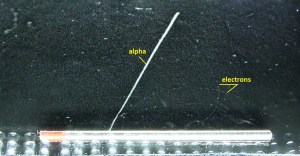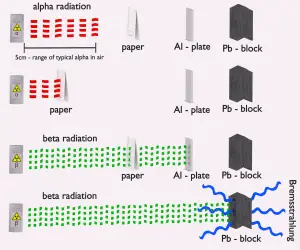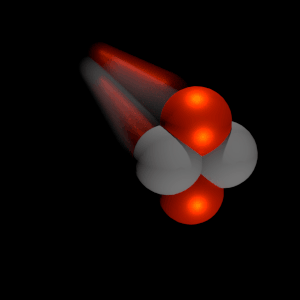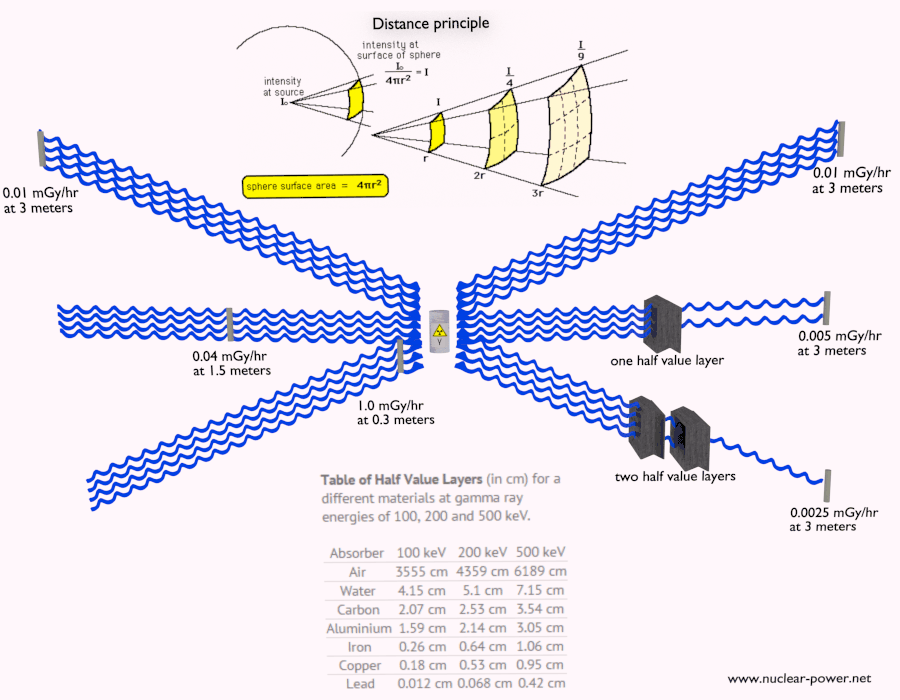Forms of Ionizing Radiation
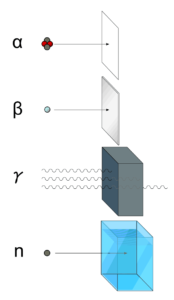
Ionizing radiation is categorized by the nature of the particles or electromagnetic waves that create the ionizing effect. These particles/waves have different ionization mechanisms, and may be grouped as:
- Directly ionizing. Charged particles (atomic nuclei, electrons, positrons, protons, muons, etc.) can ionize atoms directly by fundamental interaction through the Coulomb force if it carries sufficient kinetic energy. These particles must be moving at relativistic speeds to reach the required kinetic energy. Even photons (gamma rays and X-rays) can ionize atoms directly (despite they are electrically neutral) through the Photoelectric effect and the Compton effect, but secondary (indirect) ionization is much more significant.
- Alpha radiation. Alpha radiation consist of alpha particles at high energy/speed. The production of alpha particles is termed alpha decay. Alpha particles consist of two protons and two neutrons bound together into a particle identical to a helium nucleus. Alpha particles are relatively large and carry a double positive charge. They are not very penetrating and a piece of paper can stop them. They travel only a few centimeters but deposit all their energies along their short paths.
- Beta radiation. Beta radiation consist of free electrons or positrons at relativistic speeds. Beta particles (electrons) are much smaller than alpha particles. They carry a single negative charge. They are more penetrating than alpha particles, but thin aluminum metal can stop them. They can travel several meters but deposit less energy at any one point along their paths than alpha particles.
- Indirectly ionizing. Indirect ionizing radiation is electrically neutral particles and therefore does not interact strongly with matter. The bulk of the ionization effects are due to secondary ionizations.
- Photon radiation (Gamma rays or X-rays). Photon radiation consist of high energy photons. These photons are particles/waves (Wave-Particle Duality) without rest mass or electrical charge. They can travel 10 meters or more in air. This is a long distance compared to alpha or beta particles. However, gamma rays deposit less energy along their paths. Lead, water, and concrete stop gamma radiation. Photons (gamma rays and X-rays) can ionize atoms directly through the Photoelectric effect and the Compton effect, where the relatively energetic electron is produced. The secondary electron will go on to produce multiple ionization events, therefore the secondary (indirect) ionization is much more significant.
- Neutron radiation. Neutron radiation consist of free neutrons at any energies/speeds. Neutrons can be emitted by nuclear fission or by the decay of some radioactive atoms. Neutrons have zero electrical charge and cannot directly cause ionization. Neutrons ionize matter only indirectly. For example, when neutrons strike the hydrogen nuclei, proton radiation (fast protons) results. Neutrons can range from high speed, high energy particles to low speed, low energy particles (called thermal neutrons). Neutrons can travel hundreds of feet in air without any interaction.
Alpha Radiation
Alpha radiation consist of alpha particles, that are energetic nuclei of helium. The production of alpha particles is termed alpha decay. Alpha particles consist of two protons and two neutrons bound together into a particle identical to a helium nucleus. Alpha particles are relatively large and carry a double positive charge.
Key characteristics of alpha particles are summarized in few following points:
- Alpha particles are energetic nuclei of helium and they are relatively heavy and carry a double positive charge.
- Typical alpha particle have kinetic energy about 5 MeV. This is due to the nature of alpha decay.
- Pure alpha decay is very rare, alpha decay is frequently accompanied by gamma radiation.
- Alpha particles interact with matter primarily through coulomb forces (ionization and excitation of matter) between their positive charge and the negative charge of the electrons from atomic orbitals.
- Alpha particles heavily ionize matter and they quickly lose their kinetic energy. Therefore alpha particles have very short ranges. On the other hand they deposit all their energies along their short paths.
- For example, the ranges of a 5 MeV alpha particle (most have such initial energy) are approximately only 0,002 cm in aluminium alloy or approximately 3.5 cm in air.
- The stopping power is well described by the Bethe formula.
- The Bragg curve is typical for alpha particles and for other heavy charged particles and describes energy loss of ionizing radiation during travel through matter.
See also: Interaction of Heavy Charged Particles with Matter
Shielding of Alpha Radiation
The shielding of alpha radiation alone does not pose a difficult problem. On the other hand alpha radioactive nuclides can lead to serious health hazards when they are ingested or inhaled (internal contamination). When they are ingested or inhaled, the alpha particles from their decay significantly harm the internal living tissue. Moreover pure alpha radiation is very rare, alpha decay is frequently accompanied by gamma radiation which shielding is another issue.
We hope, this article, Alpha Radiation, helps you. If so, give us a like in the sidebar. Main purpose of this website is to help the public to learn some interesting and important information about radiation and dosimeters.
